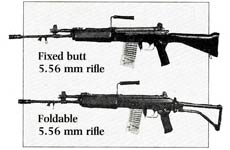Srinivas
ELITE MEMBER

- Joined
- Sep 20, 2009
- Messages
- 12,455
- Reaction score
- -26
- Country
- Location
INSAS: Packing more punch
Indian Army prepares to switch to new riflesFor decades soldiers have narrated a joke about civilians who pretend to be experts on arms: they can't tell bore from calibre and yet can be big bores despite having low calibre. After telling the joke, soldiers explain that the bore and the calibre, when they concern guns and rockets, mean just the same thing.
But of late, armies the world over are switching to lower calibres, and for good reason. Gone is the craze for the massive guns of the Navarone variety. The in thing is sleeker, lighter, more accurate conventional weapons. The concern for lightness, convenience and accuracy is greatest among the foot-slogging infantry soldier today as warfare now is shorter, bloodier and more intense.
The Indian soldier has been particularly hard-pressed. He has fought most recent battles at close quarters (Siachen, Golden Temple, Jaffna), in extreme conditions where, weighed down by his 5.1 kg Ishapore 7.62 mm rifle, he has found it hard to combat guerrillas. More so, as his rifle fires only one shot at a time and gives a jolt of 15 joules, akin to being rudely sandbagged in the middle of a battle.
Some of that is going to change. Within the next few months, the first Indian units equipped with a shining new array of personal weapons called INSAS (Indian small arms system) will be on parade at select regimental centres. The new rifle will be lighter by a kg, shorter by 18 cm, will fire a burst of three 5.56 mm calibre shots at a time and carry ammunition that, at 12 gm a bullet, weighs exactly half the current 7.62. He could thus carry twice as much ammunition as he does now.
It will also have a multipurpose fold able bayonet which could be used as a wire-cutter, saw, screw-driver and bottle-opener, tools generally carried in the soldiers' backpacks. The magazine is transparent plastic rather than the usual steel and the entire body of the weapon has been built with fibre glass reinforced plastic to conserve weight. "There is also the ethical question about the desirability of cutting trees to make guns," quips S. Venkatesan, director of the Pune based Armament Research and Development Establishment (ARDE).
The new carbine and the light machine-gun (LMG) also have the same weight and size advantages. For paratroopers, commandos and other special forces, a version of the rifle and the LMG with foldable butts has been developed. "The idea," says Venkatesan, "is to make the foot-soldier's life easier and to make him more efficient without sacrificing on lethality."

While the recent experiences in short, intense close-quarter battles provided the urgency for the 5.56 mm system, the Army Headquarters had projected the need for change from the 25-year-old Ishapore system as far back as in 1979. This was when other world armies were changing to 5.56 mm, beginning with the Americans and nato. Later, Pakistan too adopted a design from the West German small arms giant Heckler and Koch. "Only the communist powers stuck to heavier calibres," explains a general. "But chastened by the Afghanistan experience even the Russians have switched to a new 5.65 mm rifle called AKR."
After tests it was also concluded by the Indian Army that the additional range provided by the 7.62 weapons is unnecessary. "The 7.62 rifle is overdesigned. No soldier can effectively shoot at a range of 800 metres," says an army officer. Similarly, there was the crucial question of giving the rifle burst fire capability.
Many Indian generals believe that in the heat of the battle, jawans tend to poop off ammunition too fast and denying them burst fire is one way of restricting waste. However, close-quarter battle needs burst-firing capability. "Everything was studied, including figures from Vietnam and Korea where US soldiers used more than a lakh bullets to kill one enemy," says Venkatesan. Ultimately, a compromise was found in giving the rifle a three-round burst.
After evaluating various models in the world markets, Indian designers chose to play with the Ishapore design, making production easier. "There is 80 per cent commonality between this weapon and the old one." says P.K. Rao, assistant director of the small arms project at ARDE.
That, however, will cause a few problems. India's first modern rifle factory was set up in the aftermath of the 1962 war with China when, thanks to the new-found American munificence, an old, decrepit rifle plant from St Louis had been shipped to India. After equipping two generations of Indian jawans. the plant is now truly outdated. Thus the Ministry of Defence has no choice but to go shopping for an entirely new plant.
Offers are already coming in from Europe. But the army cannot wait that long and has been pressing for at least some supplies for specialised units. These are likely to be produced at existing facilities before a whole new small arms industry is built - adding a new dimension to India's armament manufacturing and exporting ability.
Read more at: Indian Army prepares to switch to new rifles : DEFENCE - India Today











